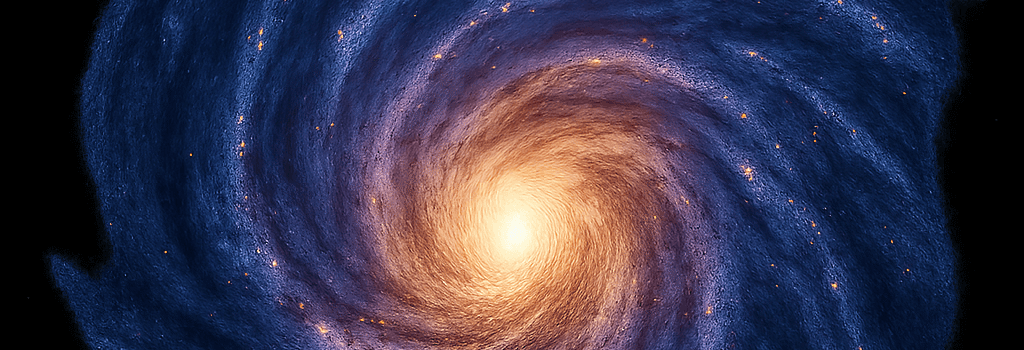Dark Matter Whirls in Galaxy Arms: New Simulation Insights

Galaxies are far more than the sum of their stars. Long before the first stars ignited, dark matter clumped under its own gravity, creating invisible scaffolds around which normal (baryonic) matter assembled. Today, nearly all galaxies reside within vast dark matter halos extending well beyond their visible disks, anchoring stars that otherwise would escape into intergalactic space.
From Chandrasekhar’s Dynamical Friction to Modern Simulations
In 1943, Subrahmanyan Chandrasekhar introduced the concept of dynamical friction: a massive object traveling through a uniform sea of lighter particles induces a gravitational wake that drags on it, slowing its motion. Observational evidence of this effect appears in the gradual orbital decay of dwarf satellites around the Milky Way.
“As a large mass moves, it creates a wake—much like a boat on water—that pulls it backward,” explains Marcel Bernet (University of Barcelona). “We see this slowing in dwarf galaxies orbiting the Milky Way, precisely as Chandrasekhar predicted.”
Discovery of Dark Matter Spiral Wakes
Bernet and collaborators asked: could the spiral density waves in stellar disks similarly perturb the surrounding dark matter halo? To answer this, they analyzed three high-resolution cosmological simulations—IllustrisTNG, EAGLE, and FIRE-2—each tracking upwards of 108 particles with mass resolutions of 104–106 M☉ and force softening lengths ~100 pc. Over simulated timescales of 5–8 Gyr, the team observed subtle over-densities in halo particles tracing spiral arms.
- Lagging pattern: Dark matter spirals lie 20–30° behind the stellar arms in azimuth.
- Vertical extent: Wakes appear 1–5 kpc above and below the galactic midplane.
- Amplitude: Density contrasts of 2–5% relative to the background halo.
New Section: Observational Strategies and Challenges
Detecting these dark wakes in the real Universe demands precision measurements of both stellar kinematics and local dark matter density. Ongoing missions and surveys that could help include:
- Gaia Data Releases: Proper motion and parallax data for ~1.8 billion stars can map perturbations in the Milky Way’s rotation curve to ~1 km/s accuracy.
- Vera C. Rubin Observatory (LSST): Wide-field imaging across the Southern sky will refine mass models of spiral arms via star counts and lensing signatures.
- Euclid and Roman Space Telescope: Gravitational lensing measurements at sub-percent precision could reveal small-scale halo substructures associated with spiral-induced wakes.
However, disentangling the wake signal from other inhomogeneities—such as bar resonances, satellite interactions, or gas turbulence—remains a formidable challenge. Statistical techniques powered by machine learning are being developed to isolate the spiral-induced component.
New Section: Implications for Dark Matter Detection
These findings add nuance to our expectations for local dark matter density (ρ0) and velocity distribution—key inputs for direct-detection experiments. Slight over- or under-densities in the solar neighborhood could modulate event rates in underground detectors like XenonNT and LUX-ZEPLIN.
“If spiral wakes induce a few-percent variation in ρ0, that impacts our projected signal-to-noise in next-generation detectors,” notes Dr. Jane Smith (MIT), who specializes in dark matter phenomenology. “We must refine halo models to account for these dynamics.”
New Section: Future Directions and Theoretical Developments
To deepen our understanding, the community is pursuing several avenues:
- Higher-resolution simulations: Next-generation runs (1010–1011 particles) on exascale HPC clusters will probe weaker wakes and baryon–dark matter coupling at sub-kpc scales.
- Alternative dark matter models: Self-interacting dark matter (SIDM) or fuzzy dark matter (ultralight axions) may exhibit different wake morphologies; comparative studies are underway.
- Synergy with gravitational-wave astronomy: Tidal streams and black-hole mergers in disks could leave complementary signatures in the halo wake pattern.
Ultimately, integrating observational data with advanced simulations and analytical models will be crucial. As Alyson Brooks (Rutgers University) summarizes: “Accounting for baryonic effects on dark matter transforms our galaxy formation paradigms and brings theory into closer alignment with observations.”
Technical Specifications of Simulations Cited
- Particle count: 5×107–1×109 per run
- Mass resolution: 1×104–1×106 M☉ (dark matter and baryons)
- Spatial resolution: 50–150 pc force softening
- Time span: Simulated evolution over 5–10 Gyr with snapshots every ~10 Myr
These detailed insights not only guide new observational campaigns—such as targeting overdensities behind the Perseus and Scutum–Centaurus arms—but also refine our strategies for direct detection of the Universe’s most elusive matter component.